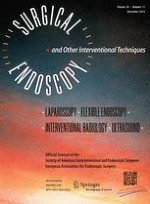Published in:

01-11-2014
A little slower, but just as good: postgraduate year resident versus attending outcomes in laparoscopic ventral hernia repair
Authors:
Samuel W. Ross, Bindhu Oommen, Mimi Kim, Amanda L. Walters, John M. Green, B. Todd Heniford, Vedra A. Augenstein
Published in:
Surgical Endoscopy
|
Issue 11/2014
Login to get access
Abstract
Introduction
The purpose of this study was to analyze the effect of residents on patient outcomes in laparoscopic ventral hernia repair (LVHR).We hypothesized that increasing postgraduate year (PGY) level would correlate with better outcomes.
Methods
The American College of Surgeons National Surgical Quality Improvement Program database was queried from 2005 to 2011 for elective LVHR. Attending only cases were used as the control, and resident cases were stratified into junior (PGY 1–3), chief (4–5), and fellow (6+) cases. Standard statistical tests and multivariate regression controlling for age, body mass index, Charlson comorbidity index, smoking, functional status, and inpatient cases were performed for trainee involvement and PGY level.
Results
There were 6,841 ventral hernia repairs that met inclusion criteria: 2,773 attending and 4,068 resident cases. There were 1,644 junior, 1,983 chief, and 441 fellow cases. Patients were similar between the attending and resident groups. The resident group had a higher rate of inpatient cases, general complications, longer operative time, and hospital length of stay. After controlling for confounders in multivariate analysis, only operative time was significantly different; resident cases were 17.7 min longer (CI 15.0–20.6; p < 0.001). There was no significant difference in the rate of wound or major complications, readmission, reoperation, or mortality between attending and resident cases. Demographics were not significantly different between the PGY level strata. On multivariate regression by PGY level with attending alone as the reference, only operative time was significantly different. Juniors (15.7 min, CI 12.2–19.2), chiefs (18.0 min, CI 14.7–21.3), and fellows (24.9 min, CI 19.1–30.7) had significantly longer cases than attending alone; all p < 0.001.
Conclusion
Trainee involvement during LVHR does not change the clinical outcomes for patients as compared to those performed by an attending only. Operative time is significantly longer with increasing PGY level, perhaps indicating the complexity of the operation or increasing trainee involvement as primary surgeon. However, patient care does not suffer, affirming the current surgical training curriculum is appropriate.